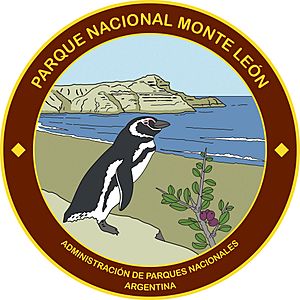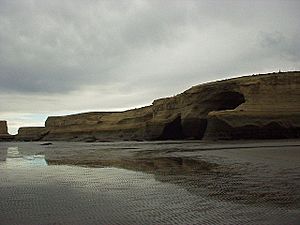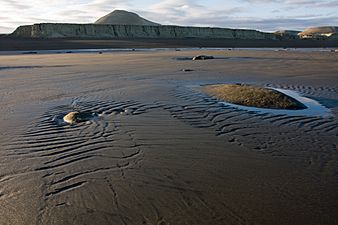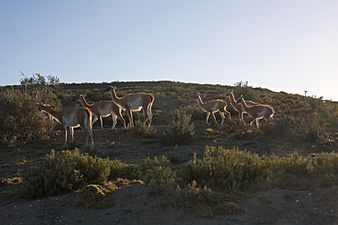Monte León National Park facts for kids
Quick facts for kids Monte León National Park |
|
|---|---|
| Parque Nacional Monte León | |
|
IUCN Category II (National Park)
|
|

Natural arches on the park's beach
|
|
| Lua error in Module:Location_map at line 420: attempt to index field 'wikibase' (a nil value). | |
| Location | Santa Cruz Province, Argentina |
| Nearest city | Puerto Santa Cruz |
| Area | 62,168 ha (621.68 km2; 240.03 sq mi) |
| Established | October 20, 2004 |
| Governing body | Argentine National Parks Administration |
Monte León National Park (Spanish: Parque Nacional Monte León) is a special protected area in Santa Cruz Province, Argentina. It was created on October 20, 2004. This park protects a big part of the Patagonian coast and steppe environment.
It is home to many different plants and animals. The park also has important places where scientists find old fossils. Monte León stretches along 36 km (22 mi) of the southern Argentine Sea coastline.
Contents
A Look Back: The History of Monte León
Who Lived Here First?
About 10,000 to 13,000 years ago, groups of hunter-gatherers lived in this area. They used the rich coastal environment to find food. The Tehuelche people are descendants of these first settlers. They used the land widely and traded with groups from far away.
When the first European settlers arrived, things changed for the local people. They started to rely on trading goods more and lost their land. This caused them to move west and work in new jobs.
Protecting the Land: Early Days
In the late 1800s, there was some tension between Argentina and neighboring Chile. Argentina wanted to protect its land in Patagonia. So, in 1876, Argentina started allowing people to collect guano (bird droppings used as fertilizer) near the Santa Cruz River.
This area was important because an Argentine commander, Luis Piedrabuena, had set up an outpost there years before. There were some disagreements with Chile over ships in the area. These events showed how important it was for Argentina to claim and protect its territory.
Exploring and Protecting Nature
Famous explorers visited Monte León in the late 1800s. Francisco P. Moreno, who helped create Argentina's National Park System, explored the area. So did the paleontologist Carlos Ameghino. An Italian missionary named Alberto María De Agostini also visited in the early 1900s.
For a long time, the Estancia Monte León was a big sheep farm. It was owned by a company and later by the Braun family. They raised sheep there until 2006. Collecting guano was a good business until about 1930.
How Monte León Became a National Park
In 1996, people suggested that Monte León should become a national park. Francisco Erize, who used to lead Argentina's National Parks Administration, shared this idea with Douglas Tompkins. Tompkins was a wealthy businessman and environmentalist who started a group called Tompkins Conservation.
In 2000, a group called Conservación Patagónica, led by Kristine Tompkins, bought the farm land. They gave the land to another group, Fundación Vida Silvestre Argentina. The plan was for this land to be given to the National Parks Administration. This happened in 2002.
Finally, on October 20, 2004, the Congress passed a law. This law officially created Monte León National Park. It became Argentina's first national park that protects both land and sea.
What Does Monte León Look Like?
Monte León National Park has amazing landscapes. You can see tall sandstone cliffs and interesting rock formations. There are also islands and wide beaches. Sometimes, narrow bays and sandbars appear when the tide is low.
The park's coast is a small but important part of Argentina's entire coastline. It is a beautiful place to explore.
- Monte León National Park scenery
-
A group of guanacos in the nearby grasslands.
Weather in the Park
The weather in Monte León is usually cold and dry. It's known as an arid or semi-arid climate. The average temperature for the whole year is about 6.8 °C (44.2 °F).
In winter, temperatures can drop below freezing. But in summer, they can go above 30 °C (86.0 °F). The park gets about 250 mm (9.8 in) of rain each year. Most of this rain falls in autumn and winter. Winds are common, averaging 15 and 20 km/h (9.3 and 12.4 mph). Sometimes, strong gusts can reach up to 100 km/h (62 mph).
Amazing Animals and Plants
Plants of the Patagonian Steppe
The Patagonian steppe might look empty at first. But it has many different kinds of plants. In 1880, Carlos Spegazzini, a founder of botany in Argentina, found new grass species here. He was part of a science trip.
Native people used resin from the calafate plant like chewing gum. This was thought to keep their teeth healthy. Wild thyme is also used a lot in local cooking. Many other plants in the park have medicinal uses. After cold winters, you can often see beautiful, colorful flowers blooming.
Wildlife: Who Lives Here?
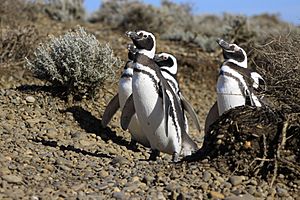
Monte León is home to about twenty kinds of birds that live near the coast and sea. You can find several types of penguins here. The park has Argentina's fourth-largest group of Magellanic penguins, with about 60,000 birds!
There are also three kinds of cormorants: the red-legged cormorant, the rock shag, and the imperial shag. Large, flightless birds called ñandús (rheas) also live here.
The cold ocean waters are full of many fish. The park is also home to large mammals. You can see big groups of sea lions. Southern right whales visit the waters too. On land, you might spot pumas and groups of guanacos. Monte León is the only place in the world where pumas are known to hunt and eat penguins!
See also
 In Spanish: Parque nacional Monte León para niños
In Spanish: Parque nacional Monte León para niños


